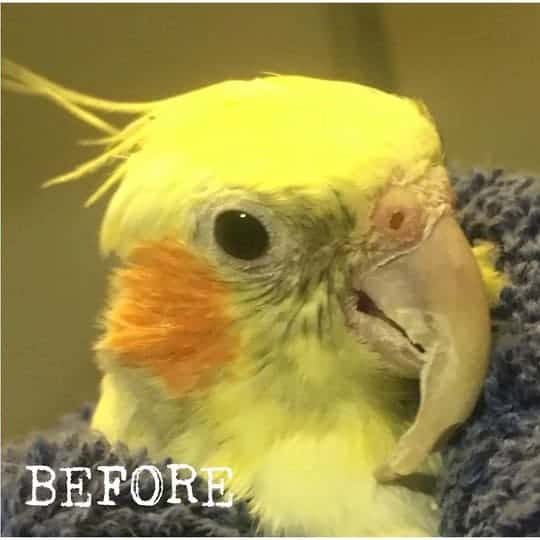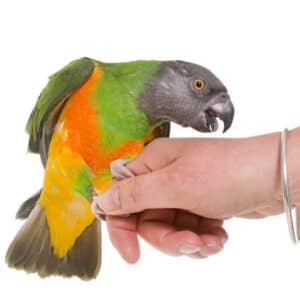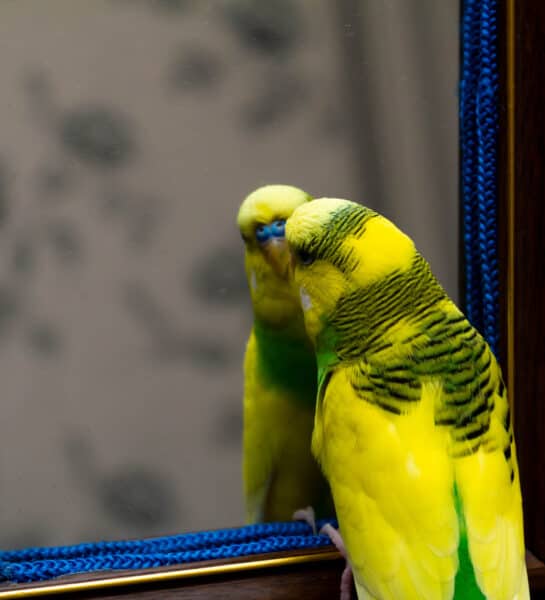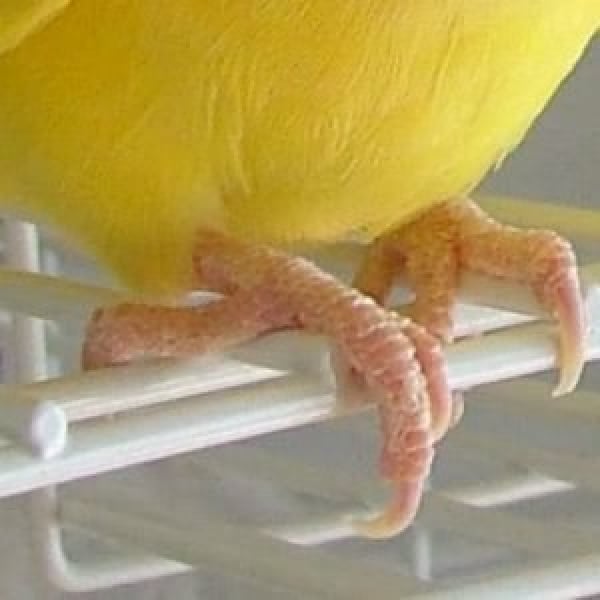
How a Magician’s Accessory Caused Mango’s Toenail and Toe Joint to Vanish (and it wasn’t an illusion)
Last Updated on by Mitch Rezman
Accidents around the home are far too common when it comes to parrots. I have many years of experience and yet, I want to show you just how easily someone with my skill level can still allow something to happen that shouldn’t. This is how Mango lost a joint from his toe when he was very young.
I have a friend who is a would-be magician. He loves to do flashy tricks with things like magician’s thread. This material is about the same color as — INVISIBLE. Perhaps you might think it looked much like a blonde baby’s hair if you could see it at all. The stretchy fiber is about as visible as a spider’s web thread when in low light. It feels much like an unraveled thread from a ladies hose.
You just can’t see magician’s thread. That’s the whole point. An illusionist can use it to manipulate items like “floating” business cards and make people believe they are levitating them. A very cool trick that turned out to be hazardous to my Mango!
Somehow while showing me a trick, which was quite impressive, a small length — just an inch or less, a fragment really — of this thread got away from him and fell to the floor. Neither of us saw it fall because it just can’t be seen and it fell on a natural stone tile floor which is nearly impossible to locate anything on. I couldn’t see it nor could he so no one noticed.
Mango was only a few months old and still growing rapidly. He seemed healthy and happy and didn’t chew at his toes any more than any normal baby parrot does in order to properly clean and groom their feet. He loved a good toe massage and often spent time enjoying a gentle massage to each toe. Nothing appeared amiss in any way.
Life continued and days passed by, all too quickly as they do in today’s modern, hectic world. One day I noticed Mango paying quite a lot more attention to one toe than the others so I felt a close examination was in order.
At that early age, Mango would readily lie on his back very calmly and allow me to look at his feet and toes. I could find no reason at all for his excessive attention to that one toe, yet I felt there had to be a reason for the unusual amount of toe grooming. I didn’t happen to have one of those nice lighted magnifiers that Mitch wears on his head during bird exams, but I had the next best thing — a lighted craft magnifier, one of those mounted on a swing arm that has a round magnifying lens encircled by a fluorescent light bulb that is very bright.
I was able to see what appeared to be a small hair wrapped around the toe and, with a pair or sterilized tweezers and assistance holding the foot still, carefully unwrapped what appeared to be the entire piece of thread. I checked and double checked that no more remained, but as I said before, the magic accessory is made to be invisible and the small, tightly wrapped piece that remained was totally invisible even under strong magnification. Now my eyes are not the best, but my friend has exceptional eyesight and he could see no remnant under the strong magnification.
Mango seemed perfectly happy to have the threat removed. We both watched him see if he went back to picking at the toe and he did not do so.
Short science lesson: The reason wild birds’ feet do not freeze in the coldest weather is that the arteries and veins in their feet and toes form a fine network of very tiny vessels, unlike the much larger (comparatively) ones in human feet and toes. Because of this genetic adaption, their toes do not turn blue when circulation is seriously reduced. With the scaly appearance of the reptilian-like feet and toes, it becomes be even more difficult to visually see any reduced circulation to a small toe joint. End of a science lesson.
Mango continued to ignore his toe other than for normal grooming, using it very effectively for playing, eating, hanging upside down on his cage and toys, grabbing onto clothing to position himself exactly where he desired and crawling into and out of his Snuggle Hut bed that hung from the top bars of his cage. I fully and completely believed we had successfully removed every tiny bit of this invisible thread that had gotten wrapped around the first joint of one of his back toes. Mango clearly was in no pain, there was no abrasion to his toe and, I thought all was well.
So much for me thinking!! Even with my years of experience caring for, breeding and loving parrots, my best thinking was simply wrong in this case.
We had experienced a rather harsh tropical wave passing through the area, drenching us with rain. The tropical storm winds (sustained wind of 45+ miles per hour qualify as a tropical storm but gusts were frequently much higher) had blown branches and small limbs from the large trees in the back yard, trash from the neighbor’s ill-prepared properly had blow into the yard creating even more mess and to top it all off, the storm drain had stopped up with debris stopping our back yard from draining. I’d spend hours outside cleaning up as much of this havoc as possible and another few hours unstopping the storm drain so the property could drain.
When I returned inside, Mango wanted attention of course, so I picked him up and sat down to play with him. He reached up to take a toy from my hand and suddenly I saw that his nail and the tiny first joint of his rear inside toe were GONE! Disappeared! Vanished! I was baffled at first but began to think of what might have happened. There were other birds in the house but if one of those had bitten off a portion of the toe, there would be evident bleeding at the very least but more likely would have been a toe dangling from a remaining tendon or thread of skin plus blood. That would have been a truly alarming sight.
There was not a drop of blood to be seen anywhere. The end of his toe was smooth, with no bone to be seen. In fact, there was just a little stump where the joint had once been and the skin covered it as if there had never been another portion of the toe and a nail there.
Then I recalled the magician’s thread incident from a couple of weeks earlier. It became clear to me what had happened. The circulation had been damaged in his toe so badly that without any evident process, the joint grew new skin and allowed the harmed portion to drop away at some point without being noticed.
Now, the moral of this story is not that I had been careless because I really hadn’t and it isn’t that I didn’t carefully remove the known constriction when it was seen. The point is that at any time a thread that is very difficult for you to see can get wrapped around your parrot’s body at some point and cause damage that could end up with lost of a toe — or much worse. It could as easily have been wrapped around his neck or wing or entire leg. It could have cost not just a small toe joint but an entire wing or his life.
It is critical as parrot owners that we be vigilant about anything in the house that can wrap around our feathered kids and cause them harm. This means you must examine all toys containing thread or rope to be sure there are no pieces that could capture a body part or be ingested. You must be aware of clothing you wear that your bird climbs on that may inadvertently become a similar hazard. If your parrot sleeps in a birdie bed of any type, it should be examined for beak customization that may have left an area that could constrict your bird in any way and appropriate trimming should be done right away. That blanket you and your parrot love to snuggle under while watching movies together has to be examined also; while snuggled with you, that little beak may be very busy pulling loose threads that can wrap around your bird’s appendages. If you sew or do needlecraft, then you have to watch your supplies because they could offer an interesting place for your bird to explore, a very risky proposition. Fishing tackle can provide a thin, clear line that can be nearly impossible to spot on your parrot’s foot or leg. The sources of potential threads or items that can twist around a toe, leg, or other anatomical part are virtually endless.
Of course, if the thread that had captured Mango’s toe had been bright red or at least not made to be invisible, it would have been easier to see on his toe. But any color thread or fiber in his brightly colored feathers could have been just as impossible to locate.
For the sake of your parrot or small companion bird, be extremely cautious about anything it can wrap around any part of its body. You might not be as lucky as Mango and I were. He simply lost a toenail and small piece of the toe and I will always carry a feeling of guilt for having allowed that to happen. I can only imagine how much worse that would be had he died and I’d lost my feathered baby. The feeling of guilt would be overwhelming.
So the real moral of this story is: be vigilant and prevent the loss of your beloved bird and the lifelong feeling of guilt that would go it with.
On a lighter note, Mango does not seem to miss his toenail and a tiny bit of missing toe. He gets around just fine and doesn’t appear to notice in any way that something is a little different about that one rear toe. He uses the remaining toe to grasp just as effectively as with the other rear toes except that he can’t hang upside down by just that toe name as he would be able to have this event not happened.
No amount of careful housekeeping can ensure that one piece of human hair, a cat or dog hair, or a bit of other fiber won’t escape your best efforts. Do examine your parrot’s feet and toes and, while petting your bird, be sure that no other areas feel constrained. Observe him or her grooming and notice if particular and repeated attention is paid of one area and, if you do notice such behavior, examine the area carefully or take your parrot to your avian vet to check that nothing is wrong with the area that appears to be getting too much grooming.
It seems to make common sense to me to believe that overgrooming an area because of a situation of a wrapped around thread or fiber could potentially become a habit and result in breaking feathers or even plucking that area. The habit of over-grooming can develop into full-blown plucking which is a really difficult habit to break, even when it develops simply as a habit. Just ask anyone who smokes cigarettes; one test puff was enough for many to lead to a lifelong habit that people find very difficult to successfully break forever. Nail-biting in humans is another example of a habit that can easily be formed but hard to break.
Parrots are similar in that once they learn a behavior over some annoyance such as a thread in the wrong place they can become habitual toe chewers or feather chewers. Be safe rather than sorry and make sure there are no loose fibers lying around your house. Regularly examine your little feathered pal for any unusual items on its body.
Psychology 101 lesson: Any behavior repeated for seven days in a row becomes a habit. This can apply to good things such as exercising seven days in a row or eating a better diet for a week — just as easily as it applies to bad behaviors. So, during the period from filling up on this Sunday Brunch until you fill up again next Sunday, why not use those seven days to develop a good behavior for you and your bird; perhaps by spending an extra 30 minutes together first thing in the morning or sharing healthy dinners together? This is a habit that can enrich both your life and your parrot’s life. End of psych 101 lesson.
Science lesson #2: A parrot is defined as any bird with a hook-shaped beak that also has feet on which two toes point forward and two toes point backward. This allows the parrot to grasp food as it eats or cracks nuts and seeds. Birds that are no parrots generally have soft, more pointed bills and do not use their feet for grasping food. Another type of foot found on waterbirds is the webbed foot used for swimming, perhaps the most interesting of which is the Blue Footed Booby.
Author Profile

Latest entries
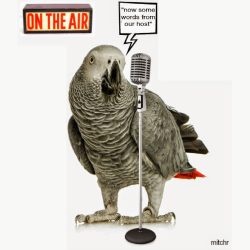 Bird & Parrot CareJune 20, 2025Understanding the Best Way to Use Prevue Pets Mimic Me Voice Trainer
Bird & Parrot CareJune 20, 2025Understanding the Best Way to Use Prevue Pets Mimic Me Voice Trainer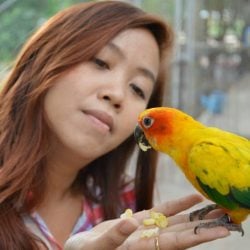 Bird BehaviorJune 6, 2025How Do I Keep My Parrot From Dumping His Food Every Day?
Bird BehaviorJune 6, 2025How Do I Keep My Parrot From Dumping His Food Every Day?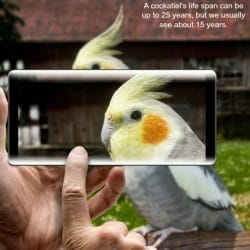 Birds & LightingMay 16, 2025I Am Seeking Clarity About Lighting for My Birds Cage
Birds & LightingMay 16, 2025I Am Seeking Clarity About Lighting for My Birds Cage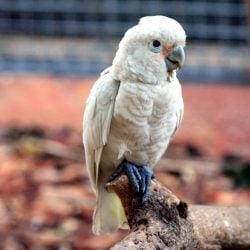 Bird RescueApril 29, 2025How Do We Re-Home a 17 yr Goffin Cockatoo?
Bird RescueApril 29, 2025How Do We Re-Home a 17 yr Goffin Cockatoo?
